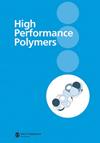Analysis of the impact of exfoliated graphene oxide on the mechanical performance and in-plane fracture resistance of epoxy-based nanocomposite
IF 1.6
4区 化学
Q3 POLYMER SCIENCE
引用次数: 0
Abstract
Graphene oxide (GO) is a versatile material, derivative of graphene, and it has gained significant attention in the field of polymer nanocomposites due to its exceptional properties and unique structural features. These characteristics make it a successful secondary reinforcing agent for enhancing mechanical performance, fatigue resistance, and other various physical and thermal properties of nanocomposites. However, the low fracture toughness of nanocomposite has restricted the overall structural applications. In this research work, the epoxy nanocomposites were prepared with different weights of exfoliated graphene oxide (E-GO) nanoparticles by using a dual mixing probe ultra-sonication for homogeneous distribution and proper dispersion. A substantial enhancement in mechanical performance and fracture toughness of nanocomposite was observed. The good dispersion and interfacial adhesion among E-GO and epoxy matrix were investigated through the critical analysis of the fracture surfaces of the nanocomposite. The enhancement of mechanical performance of E-GO nanofiller-reinforced epoxy composite was observed superior at 1 wt. % of GO60 particle concentration. The maximum increment of mechanical properties such as tensile strength, flexural strength, and work of fracture were 40.763, 39.23, and 12.106 % respectively, whereas maximum tensile modulus and flexural modulus were 19.3724, 27.63 % at 1.5 wt. % of GO60 as compared to the neat composite. However, in the case of fracture toughness and energy, maximum improvement of 1.256 Mpa.m剥离氧化石墨烯对环氧基纳米复合材料机械性能和平面抗断裂性能的影响分析
氧化石墨烯(GO)是一种多功能材料,是石墨烯的衍生物,由于其优异的性能和独特的结构特征,它在聚合物纳米复合材料领域备受关注。这些特性使其成为一种成功的二次增强剂,可提高纳米复合材料的机械性能、抗疲劳性以及其他各种物理和热性能。然而,纳米复合材料较低的断裂韧性限制了其在整体结构上的应用。在这项研究工作中,采用双混合探头超声波法制备了含有不同重量剥离氧化石墨烯(E-GO)纳米颗粒的环氧纳米复合材料,以实现均匀分布和适当分散。结果表明,纳米复合材料的机械性能和断裂韧性大幅提高。通过对纳米复合材料断裂表面的临界分析,研究了 E-GO 与环氧基体之间良好的分散性和界面粘附性。E-GO 纳米填料增强环氧树脂复合材料的机械性能在 GO60 颗粒浓度为 1 wt.与纯复合材料相比,1.5 wt. % 的 GO60 可使拉伸强度、弯曲强度和断裂功等机械性能分别提高 40.763 %、39.23 % 和 12.106 %,拉伸模量和弯曲模量分别提高 19.3724 % 和 27.63 %。然而,在断裂韧性和能量方面,观察到 GO60 的重量百分比为 1 时,断裂韧性和能量分别提高了 1.256 Mpa.m1/2 和 0.472 KJ/m2。这种提高主要是由于纳米复合材料增强了抗平面裂纹扩展的能力。此外,聚合物纳米复合材料热力学性质的亮点是具有最佳的存储模量和阻尼系数,重量百分比为 1 的 GO60 纳米复合材料的存储模量和阻尼系数分别为 4066.75 兆帕和 0.46。此外,1 wt.% 的 GO60 纳米复合材料具有更高的热稳定性,在 413.65°C 的温度下可承受高达 50% 的材料降解。
本文章由计算机程序翻译,如有差异,请以英文原文为准。
求助全文
约1分钟内获得全文
求助全文
来源期刊

High Performance Polymers
化学-高分子科学
CiteScore
4.20
自引率
14.30%
发文量
106
审稿时长
1.2 months
期刊介绍:
Health Services Management Research (HSMR) is an authoritative international peer-reviewed journal which publishes theoretically and empirically rigorous research on questions of enduring interest to health-care organizations and systems throughout the world. Examining the real issues confronting health services management, it provides an independent view and cutting edge evidence-based research to guide policy-making and management decision-making. HSMR aims to be a forum serving an international community of academics and researchers on the one hand and healthcare managers, executives, policymakers and clinicians and all health professionals on the other. HSMR wants to make a substantial contribution to both research and managerial practice, with particular emphasis placed on publishing studies which offer actionable findings and on promoting knowledge mobilisation toward theoretical advances. All papers are expected to be of interest and relevance to an international audience. HSMR aims at enhance communication between academics and practitioners concerned with developing, implementing, and analysing health management issues, reforms and innovations primarily in European health systems and in all countries with developed health systems. Papers can report research undertaken in a single country, but they need to locate and explain their findings in an international context, and in international literature.
 求助内容:
求助内容: 应助结果提醒方式:
应助结果提醒方式:


